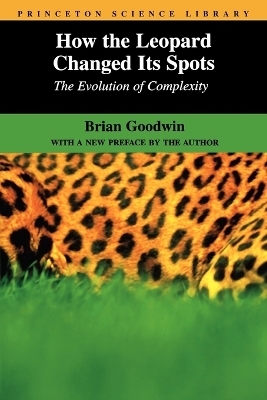
How the Leopard Changed Its Spots
The Evolution of Complexity
Seiten
2001
|
Revised edition
Princeton University Press (Verlag)
978-0-691-08809-9 (ISBN)
Princeton University Press (Verlag)
978-0-691-08809-9 (ISBN)
Do genes explain life? Can advances in evolutionary and molecular biology account for what we look like, how we behave, and why we die? This intervention into biological thinking argues that such genetic reductionism has limits. It shows how an understanding of the self-organizing patterns of networks is necessary for making sense of nature.
Do genes explain life? Can advances in evolutionary and molecular biology account for what we look like, how we behave, and why we die? In this powerful intervention into current biological thinking, Brian Goodwin argues that such genetic reductionism has important limits. Drawing on the sciences of complexity, the author shows how an understanding of the self-organizing patterns of networks is necessary for making sense of nature. Genes are important, but only as part of a process constrained by environment, physical laws, and the universal tendencies of complex adaptive systems. In a new preface for this edition, Goodwin reflects on the advances in both genetics and the sciences of complexity since the book's original publication.
Do genes explain life? Can advances in evolutionary and molecular biology account for what we look like, how we behave, and why we die? In this powerful intervention into current biological thinking, Brian Goodwin argues that such genetic reductionism has important limits. Drawing on the sciences of complexity, the author shows how an understanding of the self-organizing patterns of networks is necessary for making sense of nature. Genes are important, but only as part of a process constrained by environment, physical laws, and the universal tendencies of complex adaptive systems. In a new preface for this edition, Goodwin reflects on the advances in both genetics and the sciences of complexity since the book's original publication.
Brian Goodwin is Professor of Biology and Coordinator of Holistic Science at Schumacher College, Devon, UK. He is the editor of Theoretical Biology: Epigenetic and Evolutionary Order from Complex Systems and the coauthor of Form and Transformation and Signs of Life.
Preface to the Princeton Science Library Edition vii Preface xi Acknowledgements xix Chapter 1 Whatever Happened to Organisms? 1 Chapter 2 How the Leopard Got Its Spots 18 Chapter 3 Life, the Excitable Medium 42 Chapter 4 Living Form in the Making 77 Chapter 5 The Evolution of Generic Forms 115 Chapter 6 New Directions, New metaphors 169 Chapter 7 A Science of Qualities 196 References 238 Further Reading 242 Index 245
| Erscheint lt. Verlag | 18.2.2001 |
|---|---|
| Reihe/Serie | Princeton Science Library |
| Verlagsort | New Jersey |
| Sprache | englisch |
| Maße | 152 x 235 mm |
| Gewicht | 397 g |
| Themenwelt | Naturwissenschaften ► Biologie ► Evolution |
| ISBN-10 | 0-691-08809-8 / 0691088098 |
| ISBN-13 | 978-0-691-08809-9 / 9780691088099 |
| Zustand | Neuware |
| Haben Sie eine Frage zum Produkt? |
Mehr entdecken
aus dem Bereich
aus dem Bereich
Wie die Vernichtung der Arten unser Überleben bedroht - Der …
Buch | Softcover (2023)
Penguin (Verlag)
CHF 20,95


